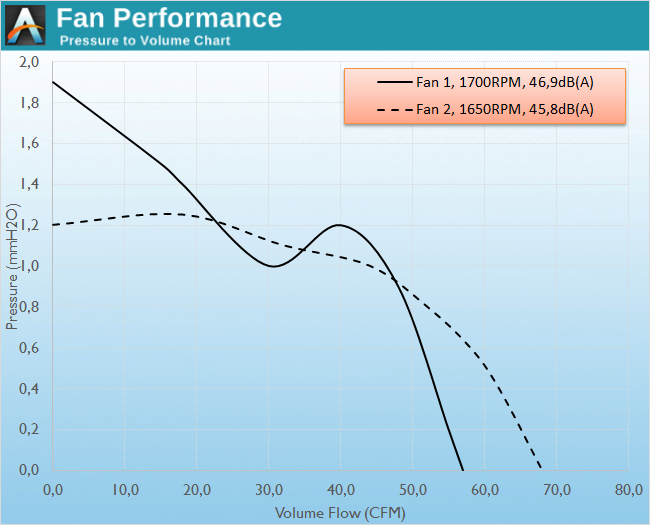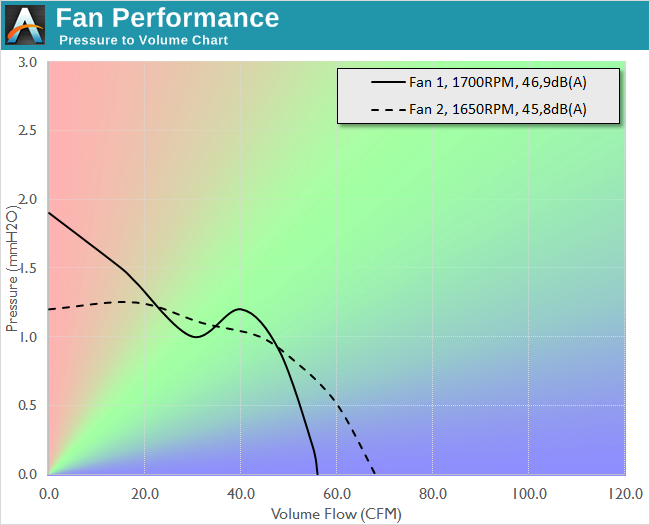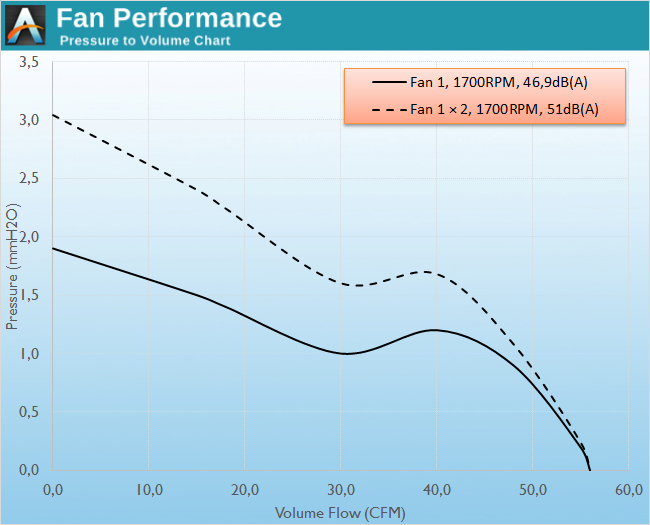The Corsair SP (Static Pressure), AF (High Airflow) 120/140mm Fan Review
by E. Fylladitakis on November 25, 2015 8:00 AM ESTFan Testing Methodology
For our first fan review we want to talk about the performance of fans and discuss how we will be testing them in our upcoming articles. This will serve as both a reference point for readers and manufacturers, as well as a chance to receive feedback and input on what we're doing before our first roundups start coming out. A large percentage of computer users are unconcerned with the actual performance of any given fan; most base their choices on recommendations and are swayed by marketing claims of "noiseless operation" and "astounding performance". Advanced users and enthusiasts are using up a lot of grey matter on the topic, seeking to find the best possible solution over dozens of possible choices. Regrettably, even if the user possesses the will and the knowledge to select a product suitable for his/her needs, they are often limited to the manufacturer's specifications, which usually are vague at best.
The fan manufacturers typically provide only a few performance figures, such as the static pressure and maximum volume flow ratings of a fan. However, even if these figures are 100% accurate (and they frequently are not), they are entirely useless to the end consumer. There are many who believe that a high static pressure rating is good for coolers and a high volume flow rating is good for case fans, but this is far from accurate. Maximum static pressure is taken at zero volume flow and maximum volume flow means zero static pressure; either scenario is impossible under real-world conditions. Furthermore, the maximum volume flow is usually calculated from the maximum velocity recorded at the exit of the fan. This is also entirely unrealistic as the fluid flow will definitely not be even across the entire exit area of the fan. The result is that retail products tend to have actual volume flows significantly lower than their specified maximum CFM ratings.
To measure the actual performance of a fan, the user has to know the P-Q (pressure to volume) chart of the fan. Here we measure the amount of applied pressure restriction, measured in mmH2O (where 1 mm H2O is the equivalent of 9.81 Pascals - one Pascal is the pressure required to accelerate 1 kg of mass at a speed of 1 meters per second squared per square meter) required to give a specific volume flow (measured in cubic feet per minute or CFM). The more the flow is restricted, the less volume flow is generated and the higher the pressure of the fan is. Still, some of the computer users who actually know how to interpret a P-Q chart are frequently misconceived that a P-Q chart is depicted by a straight line, such as this:
This is the misconception about pressure to volume - reality is a non-linear response
Unfortunately, this could not be further from the truth. The shape of the curve varies between the maximum static pressure and maximum volume flow rating, depending on several dozens of factors, mainly having to do with the design of the blades and the torque (the pushing power) of the engine. As such, two near-identical fans can have completely different behavior, which can be muddied by the actual 'naming' of the fan as an added element of confusion.
For example, the following chart depicts the P-Q chart of two fans. The first fan has a higher static pressure rating than the second and they both have an equal maximum volume flow (on paper), yet the second fan is a better selection for use as a case fan as it performs better when there are few obstructions.
Fan 2 is preferred in low impedance scenarios (low mmH2O)
as it gives higher airflow (>60 CFM under 0.6 mmH2O)
Unfortunately, the calculation of the impedance (resistance to move air) the fan will face by a grill/cooler/radiator/filter can be very difficult to assess without specialized equipment. It can be measured but it depends on far too many variables, including several environmental figures, such as the temperature and the air density. Even if we did extract a specific graph for every single part, the actual graph would be different for every single user. Therefore, it is not practical to give a graph depicting the exact impedance that an item has. It is however possible to provide an usable estimate, which we will be doing so in our future cooler and radiator reviews. The impedance of different items that can restrict the airflow looks like this:
Where the impedance line intersects with the fan's performance curve, that's where the fan will operate.
So a low impedance item generates 0.3 mm H2O of pressure and hits the fan curve at ~63 CFM in this case.
The green line depicts a high impedance item, such as a very dense liquid cooling radiator. The purple line is for a medium impedance item, such as a cooler. The black line is for a low impedance application, such as a case fan with a simple finger guard or a clean filter. For example, the medium impedance item in the graph above would have the fan moving about 32 CFM. There are no actual conditions under which the actual performance of a fan will go very near its maximum static pressure point nor will a fan will reach its maximum volume flow. This allows us to provide a usable estimate when testing coolers, radiators and similar devices. For example, a "very high impedance" radiator would lean towards the left side of the red area, while a "medium to low impendance" cooler would lean towards the right side of the green area.
Where the impedance line intersects with the fan's performance curve, that is the aiflow impedance pressure drop, or by how much of a pressure drop the device (cooler, radiator, filter, etc.) will cause to a fan. Note that the impedance line is highly unlikely to intersect at the same airflow impedance pressure drop point for different fan performance curves. As such, the pressure drop is not something that can be universally assessed for each application but depends on the fan itself as well.
We will be using the above style of graph for the delivery of our results, maintaining the same axes for 120mm/140mm fans for easy comparisons. The red, green and blue areas should be consulted for high, medium and low impedance applications respectively. Even if the axes do shorten, note that the areas remain nearly identical if the range of both axes is reduced by the same percentage.
When the expected obstruction is high, some manufacturers use two fans in series (a push-pull configuration). This is often the case with liquid-cooling radiators. When two fans are placed in series, their pressure at a given airflow is increased (but not doubled) and thus the airflow at a given pressure point is increased, as seen in the following example.
Using two fans in a push/pull configuration.
Thus at a static pressure of 1.5 mmH2O (medium impedance device, such as an air cooler), volume flow increases here from 15 CFM to 43 CFM. However, their maximum airflow will always be the same; therefore, this approach makes no sense when the impedance is low and only in high static pressure situations.
How AnandTech Will Test Fans
We will begin testing fans using an Extech HD350 differential manometer with a Pitot tube, an Extech AN200 velocity meter, and a custom apparatus designed for this specific purpose. The apparatus has a mechanism that allows us to test the unobstructed (maximum) volume flow of a fan, the fully obstructed (maximum static) pressure of the fan, and multiple points in between, allowing us to compose the actual P-Q performance chart of any fan. However, we are measuring the actual airflow generated by the fan, not that calculated by our maximum recorded air velocity.
For noise measurements, we are using an Extech HD600 high sensitivity SPL meter. The noise of the fan is measured from 15 centimeters away, not one meter as IEC certifications require, as that would be far too great a distance to measure differences between nearly silent products. Note however that we are measuring the noise level of a fan with its flow unobstructed. The addition of far grills, the installation on a cooler, and any other form of obstruction will increase the generated noise, as aerodynamic noise will be added into the environment.
We also plan on testing fans at their "stock" 12 V PC voltage and at a lower voltage, which will most usually be 7 V. This may not always be practical on some fans (i.e. very low speed fans may have their performance degraded far too much), but when it is we will do so. While it's impossible to state how any fan will perform in every situation, we will be able to provide at least a more rigorous view of each fan's performance. In the meantime, any feedback on our approach to testing or requests for additional tests is welcome.















92 Comments
View All Comments
DanNeely - Wednesday, November 25, 2015 - link
A suggestion for when you've got data on more fans. Since the scales on the graphs aren't constant; it would be really helpful for comparison if Bench was able to take the datapoints used to generate the performance curves and use them to create a single combined chart for the user selected set of fans/speeds.BurntMyBacon - Tuesday, December 1, 2015 - link
A max and min speed chart also needs to be in there as user selected fan speeds ignore the fact that some fans can spin quicker/slower than others are capable of spinning.Stuka87 - Wednesday, November 25, 2015 - link
My Corsair 380T came with the LED version of the fans and I was not happy with them at all. I ended up changing them out for the Enermax "Batwing" LED fans (which have removable blades for cleaning) which are much quieter but also have better airflow.supastar1568 - Wednesday, November 25, 2015 - link
Very well written write up with lots of good information.Curious, how did you go about increasing/decreasing the air resistance levels for the fans? As an mechanical engineer, I've been reading up on fan curves for work and I believe an adjustable duct type thing is common. I've always been curious to how this part is done.
Also, for anyone interested, the AMCA 210 Standard has lots of good info as well. A quick google search will bring you to the .pdf.
simonpschmitt - Wednesday, November 25, 2015 - link
Hey, nice to see a more in depth review of the matter.Just two suggestions:
First, why are you plotting pressure over volume? Iwould have done it the other way around.
Second, could you measure the impedance (ballpark figures) of some typical obstructions and post photos of them? For example finger guards, one or two tower coolers, typical filter (ideally clean and dirty, would be interessting to see the effect). Just to get a feel for the dimensions involved.
jann5s - Thursday, November 26, 2015 - link
+1EddyKilowatt - Thursday, December 3, 2015 - link
I think a necessary corollary of AT doing such a solid job of reviewing and explaining fan performance, is that they will also (have to) start measuring and publishing flow curves of the things they review that fans get hooked up to. I was mainly thinking of cases and coolers, but you are right, filters and guards qualify as well. Maybe someday that kind of data will be part of the specs that manufacturers publish.rocktober13 - Monday, November 30, 2015 - link
+1 to both suggestionsBurntMyBacon - Tuesday, December 1, 2015 - link
@simonpschmitt: "First, why are you plotting pressure over volume? Iwould have done it the other way around."Typically the controlled variable is X and the measured variable is Y. They are controlling pressure and measuring airflow so typically it would be represented as you state. That said, the data is all there and the author is technically free and correct to use R and W for variables if he chooses as long as the axis' are labeled. Though in the end, I'd just as soon have the author use the typical approach to avoid confusion.
@simonpschmitt: "Second, could you measure the impedance (ballpark figures) of some typical obstructions and post photos of them? For example finger guards, one or two tower coolers, typical filter (ideally clean and dirty, would be interessting to see the effect). Just to get a feel for the dimensions involved."
This. Very this. Also, since the author mentioned "dense radiators", measurements and photos of dense vs sparse radiators.
JanW1 - Wednesday, November 25, 2015 - link
"one Pascal is the pressure required to accelerate 1 kg of mass at a speed of 1 meters per second squared"Looks like you mixed up the definitions of a Newton and a Pascal. One Pascal is the pressure required to exert the force of one Newton per square meter. The square meter disappeared in your definition. I guess you could say "one Pascal is the pressure required to exert on a surface of one square meter the force required to accelerate 1 kg of mass at a speed of 1 meters per second squared".